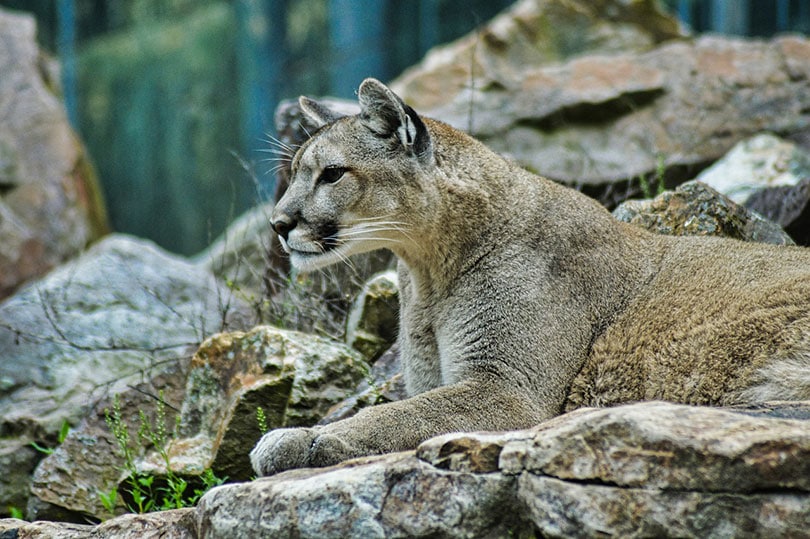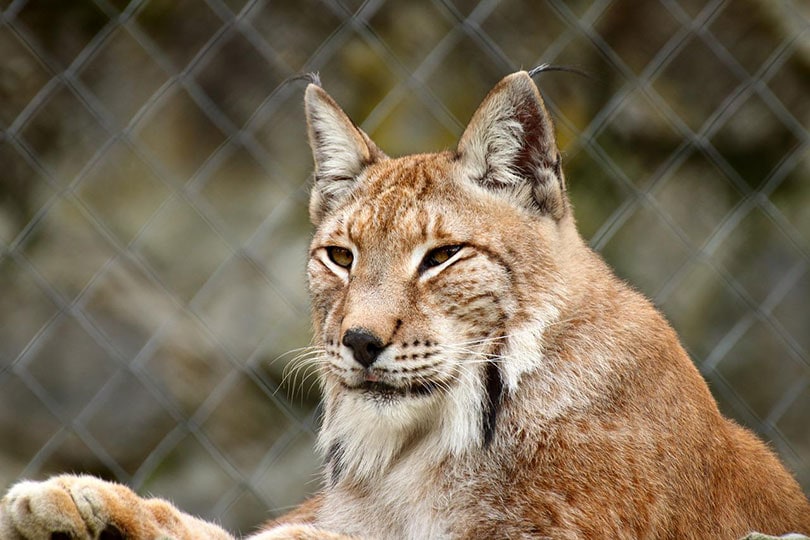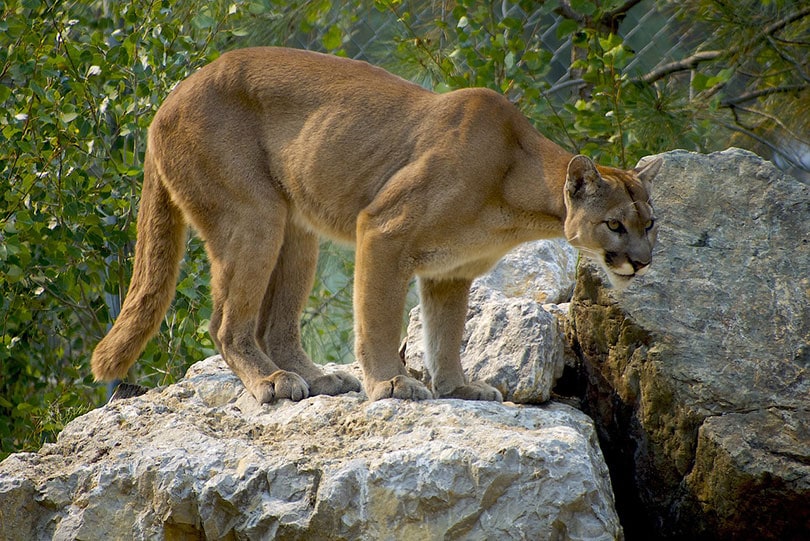Illinois is home to various wild animals. However, some people may believe that this Midwestern state has more native wild animals than it really does. Thanks to folklore and campfire stories about mountain lions, Illinois is thought to be full of cougars.
Are there any wild cats in Illinois? While the state doesn’t have any native cougars, you may still see the occasional one passing through. The bobcat is the only wild cat native to the state, but they are elusive and not easily seen.
You may not see a wild cat if you’re in the Prairie State, but that doesn’t mean they aren’t around. Let’s find out more about bobcats and cougars.

Bobcats in Illinois

| Species: | Lynx rufus |
| Weight: | 11–30 pounds |
| Lifespan: | 10–12 years |
| Color: | Tan or reddish brown with black spots |
The American bobcat (Lynx rufus) is Illinois’ only native wild cat. This cat was nearly extinct in the 19th and early 20th centuries. They were killed because they were threats to livestock, and they were hunted for their pelts.
The bobcat diet primarily consists of birds, rodents, rabbits, and squirrels. The cat plays an important ecological role in controlling populations of prey animals.
You may see a bobcat quickly pass by when you’re hiking in the woods, but the bobcat does not want to see humans. They are solitary and territorial, preferring to keep to themselves and go on their way. Since they want to run and hide from humans, they aren’t a dangerous threat. While you should never leave your pets unattended outdoors in an area with bobcats, they aren’t likely to go after dogs or cats. Backyard chickens may be another story. They are the most active between dusk and dawn, when they are hunting prey. Animals should be safely secured overnight.
While a bobcat sighting is possible anywhere in Illinois, they are typically located in the southern third of the state. There are roughly 5,000 bobcats in Illinois. They are adaptable cats that can live in various habitats. You’ll find them in densely forested areas.
Bobcat Appearance
If you see a bobcat, you may have to look twice to make sure it’s really a wild cat. These animals aren’t that much bigger than domestic housecats.
They are 2 feet tall and 2.5–3.5 feet long. Males can weigh anywhere from 22 to 40 pounds, while females tend to weigh slightly less.
The fur is yellowish or reddish-brown, with a covering of black spots. The belly is white with black spots. The ears are tufted. Their defining feature is their bobbed tail, which gives them their name. Their tails are naturally short at only around 5 inches long. Since their natural hunting grounds are meadows and fields, they don’t need the extra balance that a long tail would provide, so they did not evolve that way.
The tails are brown or tan with dark banding around them. The tips are white.
Cougars in Illinois

| Species: | Puma concolor |
| Weight: | 75–160 pounds |
| Lifespan: | 10–20 years |
| Color: | Tan, grey, or reddish brown |
Cougars are also called mountain lions or pumas. These cats have been spotted in Illinois, but they are not native to it. There are no known cougar populations in the state, but they can pass through it during their travels. Still, it’s rare to see a cougar in Illinois. Sightings have taken place in 2000, 2004, 2009, and 2013. Unfortunately, these cougars were either found dead or killed shortly after they were seen.
Before 2000, the last documented cougar sighting in Illinois was in 1862.
Cougar populations were eliminated from much of the Midwest during the 20th century. Farmers were fed up with cougars depleting their livestock, so many of the cats were hunted and destroyed.
In 2014, cougars were added to the list of protected species in Illinois. It’s no longer legal to kill, hunt, or trap the cats unless they are an immediate threat to people. This legislature may lead to future cougar recolonization in the state. If you see a cougar in your area that you feel may be a threat in the future, you must contact the Illinois Department of Natural Resources to discuss control options. Any cougar sighting should be reported to help the department learn and document where these cats may be living.
Cougars like to prey on deer, but they’re known to eat smaller animals too, such as raccoons and porcupines. Like bobcats, they are the most active during dusk and dawn, when they’re hunting. They are much larger than bobcats and have a more powerful bite. They can take down large animals with a single pounce.
Cougars are rarely seen by people and are shy, solitary animals. They keep to themselves and don’t want to interact with humans.
Cougar Appearance
The cougar is the largest wild cat in North America. They stand 2.5 feet high at the shoulders and are 7–8 feet long, including the length of the tail. They weigh 120–150 pounds, with females slightly smaller than the males.
They have tan, greyish-brown, or reddish-brown coats with long, thick, black-tipped tails. The tail can make up half of a cougar’s length. This helps them keep their balance as they run and jump.

What to Do If You Encounter a Wild Cat
Prevent the Encounter
The best way to deal with an encounter with a wild cat is to prevent it from happening in the first place. If you live in an area with bobcats or cougars, you should do what you can to prevent them from coming around your property. If you see a wild cat wander across your backyard, they’re usually on their way to another location and will leave quickly. By storing trash in secured containers and keeping your property cleared of unruly vegetation, you won’t be giving these cats a reason to stick around.
Compost material, pet food, and other food items left outside can be inviting not only to wild cats but also to other wild animals. Seal up any open areas like porches and sheds so the animals can’t find shelter near your home.

Encountering the Cat
Sometimes, despite your best efforts, you will encounter a wild cat. The first thing that you should do in this situation is pick up any small children or pets. Do not run. Wild cats are predators, and their instinct is to chase their prey. Running will trigger that instinct.
Face the cat without making eye contact. Make sure the cat has a clear exit and is not cornered. Back away slowly.
If the cat turns aggressive, make as much noise as you can. Yell, wave your arms over your head, and try to make yourself appear bigger. Open an umbrella or raise your jacket over your head. If you have anything that makes noise, like a whistle or air horn, use it.
Wild cats will prefer to flee instead of fight humans, but in the rare event of an attack, use anything that you can as a weapon. Rocks, sticks, baseball bats, pepper spray, and even your hands can be effective at getting the cat to leave you alone.

Final Thoughts
The bobcat is the only wild cat native to Illinois. There are no populations of cougars living in Illinois, but the cat can be seen occasionally passing through the state in their travels. Bobcats are much smaller than cougars. They both prefer to stay away from humans and keep to themselves.
Keeping your property cleared of overgrown vegetation, food scraps, and trash can keep wild cats and other animals from being attracted to your home. Preventing encounters with wild cats is the best way to avoid them.
If you see either of these cats in Illinois, you’ve witnessed a rare sight!
Featured Image Credit: villagequirks, Pixabay
